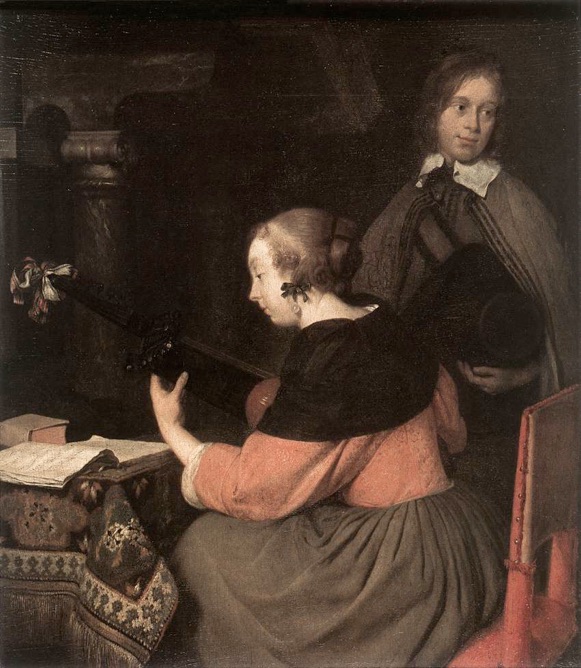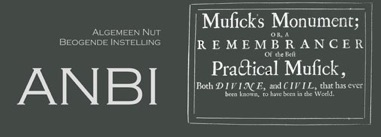Niet te Hoog. Niet te Vrooch.
Aeij mij tontsprinckt mij met gewellt,
Den Luit Heb ick te Hoog gestellt,
Had ick Leger gevangen aen,
Het sou well hebben blijven Staen,
Icarus Jonck en onbedocht,
Heeft hem daer door ten val gebrocht,
Dus neemt altijt aen Wijsen Raet,
en hout u op de Middelmaet,
Niet te hoog, niet te vrooch [vroeg].
Aeij mij! t Ontsprinckt mij met gewellt.
Den luit heb ick te hoog gestellt.
Had ick leger [lager] gevangen aen,
Het sou well hebben blijven staen.
Icarus, jonck en onbedocht,
Heeft hem daer door ten val gebrocht.
Dus neemt altijt aen wijsen raet,
en hout u op de middelmaet!
Gerard ter Borch
dr. Willem Kuiper Leerstoelgroep Historische Nederlandse Letterkunde Universiteit van Amsterdam

LACHRIMAE
Apparently the earliest surviving version of Dowland's lute Lachrimae is a dance variation in G minor. Specifically, it is a Pavan, one of the more stately courtly dances popular in Elizabethan England. But unlike an earlier generation of music called by this generic term, Lachrimae does not follow a repetitive "ground" bass pattern. Rather, the Lachrimae pavan falls into three sections, each repeated. This elegant and eminently audible structure allows the composer (who presumably played the work himself as well) strongly to highlight the artifice of his ornaments. The opening strain remains fairly straightforward, setting out the self-conscious and dramatic melancholy affect; the well-known music is rich in mournful Phrygian cadences and strident harmonic cross-relations. Yet immediately upon repeating this strain, Dowland not only adds a more rhapsodic melisma, but one that contains a wonderfully pungent A flat! In the middle strain, it is imitation that the composer vests with emotional power, as a barren bass voice echoes the plaintive rising triads of the melody; again, the second iteration is even more starkly profiled at the corresponding moment. The pavan's third strain, already rich with suspensions in inner voices, offers a final opportunity for the player/composer to exceed in rhapsodic fireworks for the final repeat. The ever-doleful Dowland nearly drowns in his own tears.
John Dowland (1562-1626)
There is some debate over John Dowland's date of birth. In 1612, Dowland wrote that he had "now entered into the fiftieth yeare of mine age," but whether that means that he was born in 1562 or 1563 remains unclear. Nor is much known about Dowland's younger years except for Dowland's claim that his music education began at an early age. He spent some time in France engaged in the service of Sir Henry Cobham and in 1588, obtained a BMus at Christ Church, Oxford.
Though unable to obtain a position within the English court, Dowland was nevertheless one of the highest paid court servants while he remained in the service of Christian IV, King of Denmark. Under Christian IV, Dowland received the equivalent of two hundred pounds a year. Dowland also enjoyed several leaves to visit England, a rather generous allowance from a court employer at the time.
The Lute Song
As the madrigal faded out of popularity in England, the lute song was imported from Continental Europe to replace it. Whereas a madrigal required multiple voices, the lute song was often for solo voice accompanied by lute. Along with Thomas Campion (1567-1620), Dowland was one of the most influential lute composers. Dowland synthesized the broadside ballad, dance music, the consort song, and the madrigal into a distinct genre, the English lute song.
During his lifetime, John Dowland published eighty-eight lute songs, sixteen psalms and spiritual songs and twenty-one dances for viols or violins with lute. All these were carefully prepared for publication by the composer. In stark contrast the majority of his lute solos have survived in much less reliable forms. Apart from the two solos that appeared in "A Pilgrimes Solace" and "A Musicall Banquet" and the nine pieces (or ten if you consider "Sir Henry Guilforde his Almaine" to be by him) that are found in "A Varietie of Lute Lessons" published by his son in 1610, his solo lute music has come down to us in sources from all over Europe with little or no direct involvement by Dowland. It is unfortunate that he never fulfilled the promise he gave in "The First Booke of Songes" to "set forth the choicest of all my Lessons in print."
Dowland's solo lute music is extraordinarily varied. It ranges from light, frivolous pieces such as "Mrs. White's Nothing" and "Lady Hundson's Puffe" to profound works expressing the darkest melancholy ("Forlorn Hope Fancy" and "Semper Dolens Semper Dowland.") His music is characterized by a tunefulness unequalled in contemporary lutenists' output and many of his solos were given texts to become lute songs. One such example is his famous pavane "Lachrimae," which he published in "The Second Booke of Songes" as "Flow my teares."






